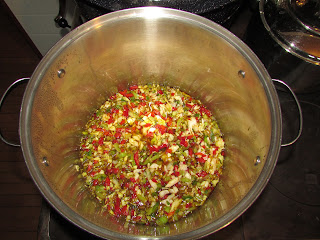Another reason I was pleased to see the recipe was because I had raised all of the vegetables it called for in our garden this year. Here is the way the recipe reads:
Piccalilli
1 quart chopped cabbage
1 quart chopped green tomatoes
2 sweet red peppers, chopped
2 sweet green peppers, chopped
2 large onions
1/4 cup salt
1 1/2 cups vinegar (5% acidity)
1 1/2 cups water
2 cups firmly packed brown sugar
1 tsp. dry mustard
1 tsp. turmeric
1 tsp. celery seed
Chop the cabbage, tomatoes, peppers, and onions.
 |
| The chopped vegetables with the salt sprinkled on top. This antique crock belonged to my great-great aunt Meme who taught me to cook and is partly responsible for my fascination with wood cookstoves. |
Mix with the salt and let stand overnight.
 |
| Vegetables and salt mixed together. This is one of those pictures where I wish we had smell-o-vision because the aroma of this mixture was fantastic. |
Next morning, drain and press to remove all liquid possible.
 |
| The chopped vegetables draining in a colander. |
 |
| I used a plate to press as much liquid out of the vegetables as possible. |
Boil vinegar, water, sugar, and spices five minutes.
 |
| The sugar, vinegar, water, and spice mixture coming to a boil directly over the firebox. |
Add the chopped vegetable mixture.
 |
| The vegetables coming to a boil after being added to the vinegar/sugar solution. You can see the water bath canner right behind this kettle over the firebox. |
Bring to a boil and pour into sterilized Kerr jars to within 1/2 inch of top. Put on cap, screw band firmly tight. Process in boiling water bath five minutes. Yield: 6 pints.
Now, here are the things I did a little differently:
1. The green peppers that I wanted to use were a little small, so I used three instead of two.
2. I don't like messing with sterilizing jars, so I just had my jars hot by putting them on top of the reservoir. Then once they were filled, I processed them for ten minutes in the boiling water bath.
3. Maybe my onions weren't large enough, but my batch yielded only four pints and a four ounce jar of piccalilli.
 |
| The finished piccalilli. |
Since making this recipe of piccalilli, I've researched this stuff a little more and found out that piccalilli varies widely by geographic area. This particular recipe may be a little more "northeastern United States" in nature because what I've read seams to indicate that Midwestern piccalilli tends to have cucumbers in it. However, I consulted my 1926 West Pottawattamie County Farm Bureau Women's Cookbook, and the two recipes for piccalilli listed there are very similar to this one. The major difference seems to be the spices. Neither one calls for turmeric or celery seed, but both call for cloves. Further, both call for white sugar instead of brown. The method is exactly the same, though.
I talked to a friend who lived in Maine for a number of years, and she said that piccalilli was served as a relish on the side there. I've read that others put it on hot dogs, sausage, or hamburgers. I'm not sure how I'll eat mine, but I know I'm going to enjoy looking at it on the shelf in the fruit room for a while first.
Use the comments section below to tell me what piccalilli is like in your area of the world.
Note 10/2/2017: Had some of this on top of my BBQ beef sandwich tonight. It was delicious and added an excellent crunch!
10/18/2017: Also excellent atop a pork burger (no bun) which I served with a mashed potato patty and corn.


































